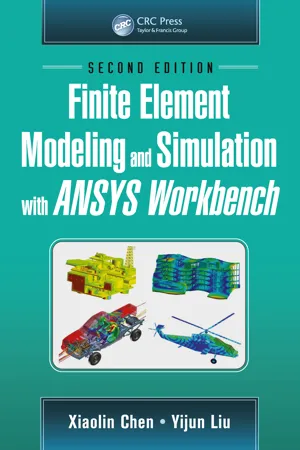
eBook - ePub
Finite Element Modeling and Simulation with ANSYS Workbench, Second Edition
- 457 pages
- English
- ePUB (mobile friendly)
- Available on iOS & Android
eBook - ePub
Finite Element Modeling and Simulation with ANSYS Workbench, Second Edition
About this book
Finite Element Modeling and Simulation with ANSYS Workbench 18, Second Edition, combines finite element theory with real-world practice. Providing an introduction to finite element modeling and analysis for those with no prior experience, and written by authors with a combined experience of 30 years teaching the subject, this text presents FEM formulations integrated with relevant hands-on instructions for using ANSYS Workbench 18. Incorporating the basic theories of FEA, simulation case studies, and the use of ANSYS Workbench in the modeling of engineering problems, the book also establishes the finite element method as a powerful numerical tool in engineering design and analysis.
Features
- Uses ANSYS Workbench™ 18, which integrates the ANSYS SpaceClaim Direct Modeler™ into common simulation workflows for ease of use and rapid geometry manipulation, as the FEA environment, with full-color screen shots and diagrams.
- Covers fundamental concepts and practical knowledge of finite element modeling and simulation, with full-color graphics throughout.
- Contains numerous simulation case studies, demonstrated in a step-by-step fashion.
- Includes web-based simulation files for ANSYS Workbench 18 examples.
- Provides analyses of trusses, beams, frames, plane stress and strain problems, plates and shells, 3-D design components, and assembly structures, as well as analyses of thermal and fluid problems.
Frequently asked questions
Yes, you can cancel anytime from the Subscription tab in your account settings on the Perlego website. Your subscription will stay active until the end of your current billing period. Learn how to cancel your subscription.
No, books cannot be downloaded as external files, such as PDFs, for use outside of Perlego. However, you can download books within the Perlego app for offline reading on mobile or tablet. Learn more here.
Perlego offers two plans: Essential and Complete
- Essential is ideal for learners and professionals who enjoy exploring a wide range of subjects. Access the Essential Library with 800,000+ trusted titles and best-sellers across business, personal growth, and the humanities. Includes unlimited reading time and Standard Read Aloud voice.
- Complete: Perfect for advanced learners and researchers needing full, unrestricted access. Unlock 1.4M+ books across hundreds of subjects, including academic and specialized titles. The Complete Plan also includes advanced features like Premium Read Aloud and Research Assistant.
We are an online textbook subscription service, where you can get access to an entire online library for less than the price of a single book per month. With over 1 million books across 1000+ topics, we’ve got you covered! Learn more here.
Look out for the read-aloud symbol on your next book to see if you can listen to it. The read-aloud tool reads text aloud for you, highlighting the text as it is being read. You can pause it, speed it up and slow it down. Learn more here.
Yes! You can use the Perlego app on both iOS or Android devices to read anytime, anywhere — even offline. Perfect for commutes or when you’re on the go.
Please note we cannot support devices running on iOS 13 and Android 7 or earlier. Learn more about using the app.
Please note we cannot support devices running on iOS 13 and Android 7 or earlier. Learn more about using the app.
Yes, you can access Finite Element Modeling and Simulation with ANSYS Workbench, Second Edition by Xiaolin Chen,Yijun Liu in PDF and/or ePUB format, as well as other popular books in Physical Sciences & Civil Engineering. We have over one million books available in our catalogue for you to explore.
Information
1
Introduction
1.1Some Basic Concepts
The finite element method (FEM), or finite element analysis (FEA), is based on the idea of building a complicated object with simple blocks, or, dividing a complicated object into smaller and manageable pieces. Application of this simple idea can be found everywhere in everyday life (Figure 1.1), as well as in engineering. For example, children play with LEGO® toys by using many small pieces, each of very simple geometry, to build various objects such as trains, ships, or buildings. With more and more smaller pieces, these objects will look more realistic.

Figure 1.1
Objects built with simple and small pieces: (a) a fire engine built with LEGO® (http://lego.wikia.com/wiki/10020_Santa_Fe_Super_Chief); and (b) a house built with many elements—bricks, beams, columns, panels, and so on.
In mathematical terms, this is simply the use of the limit concept, that is, to approach or represent a smooth object with a finite number of simple pieces and increasing the number of such pieces in order to improve the accuracy of this representation.
1.1.1Why FEA?
Computers have revolutionized the practice of engineering. Design of a product that used to be done by tedious hand drawings has been replaced by comp...
Table of contents
- Cover
- Half Title
- Title Page
- Copyright Page
- Contents
- Preface
- Authors
- 1. Introduction
- 2. Bars and Trusses
- 3. Beams and Frames
- 4. Two-Dimensional Elasticity
- 5. Modeling and Solution Techniques
- 6. Plate and Shell Analyses
- 7. Three-Dimensional Elasticity
- 8. Structural Vibration and Dynamics
- 9. Thermal Analysis
- 10. Introduction to Fluid Analysis
- 11. Design Optimization
- 12. Failure Analysis
- Appendix 1: Review of Matrix Algebra
- Appendix 2: Photo Credits
- References
- Index